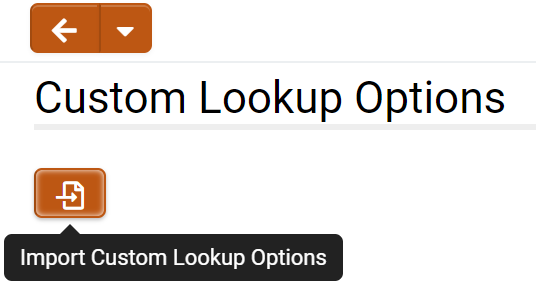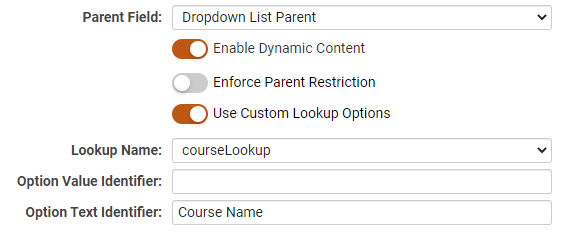Difference between revisions of "Custom Lookup Options"
Ann Vincent (talk | contribs) m |
Ann Vincent (talk | contribs) m |
||
| Line 58: | Line 58: | ||
!|Option | !|Option | ||
!|Description | !|Description | ||
| + | |- | ||
| + | ||Option Text Identifier | ||
| + | ||The name of the column whose values you want to display in the dropdown. | ||
|- | |- | ||
||Option Value Identifier | ||Option Value Identifier | ||
| − | || | + | || (Optional) |
| − | |||
| − | |||
| − | |||
|} | |} | ||
Revision as of 10:13, 24 June 2021
Overview
Custom Lookup Options allow you to import and view custom values for lookups and validation based on client-specific data. For example, you can upload a CSV file that can be referenced by a dynamic dropdown list to filter results based on previous selections.
Configuration - Essentials
Importing a New Custom Lookup
- Navigate to Global Settings > Custom Lookup Options and click on the Import Custom Lookup Options button represented by an import icon.
- You will now access step 1 one of the Custom Lookup Options Import wizard. Upload a CSV containing your custom data. The first row of the CSV must include column headers. A sample CSV is provided under the Settings Explained section below.
- Give your custom lookup a descriptive name under Lookup Name that will help you remember what it is for. Select one of the columns for the Lookup Key. The Primary Key is optional. Click Next to continue.
- Check over the sample of the uploaded data to ensure it has been processed as intended. Toggle which columns you want to include in the final import. Click Next to proceed.
- The last step will let you review the final changes. Each attribute-value pair under Lookup Value represents a value under your selected columns for a particular lookup value. Click Next to complete the import process.
Updating an Existing Custom Lookup
- To update an existing custom lookup, import the updated file and be sure to type out the exact name of the lookup you want to update in the Lookup Name field. Specify the lookup key and any primary key needed. Click Next to continue.
- You will see a warning that notifies you that an existing lookup with the same name already exists. All existing records for that lookup will be deleted and re-imported with the new updated data. Click Next to continue and click Yes on the alert pop-up.
- Click Next to finish the import.
Configuration - Advanced
Setting up Dynamic Dropdown Lists
Custom lookups can be incorporated into dynamic dropdown lists using the parent and child relationship between data. After uploading a CSV for your custom data, you can set up a series of parent and child dropdown lists that can further filter user options based on previous selections.
Parent Dropdowns
To set up a parent dropdown list, create a custom field of type Select One - Dropdown List. In the Pre-Defined Options field, map your dropdown options to the lookup keys you chose for your custom lookup. For example, a custom lookup for course registration may have a lookup key that uses 100 to denote freshman courses, 200 to denote sophomore courses, etc. When the user selects a course year from the parent dropdown, their options for the child dropdown will be filtered.
Child Dropdowns
To set up a child dropdown list, create a custom field of type Select One - Dropdown List and set the Parent Field to the parent dropdown list created above. Toggle on Enable Dynamic Content. This will expose the toggle Use Custom Lookup Options. When you toggle this on, you see additional settings to specify the lookup. Under Lookup Name, select the desired custom lookup you imported. Under Option Text Identifier, type the name of the column whose data you want to display in the child dropdown. In this example, we want to show the course name.
Settings Explained
Import Settings
| Option | Description |
|---|---|
| Lookup Name | The Lookup Name is used to identify the set of lookup options. If you want to update an existing custom lookup, ensure the Lookup Name is the same as the existing custom lookup. |
| Lookup Key | The Lookup Key is a non-unique identifier used to return all records with a matching Lookup Name. |
| Primary Key | (Optional) The Primary Key is an optional unique key used to return a single record that matches the Lookup Name and Primary Key value. Records without a matching Primary Key will be imported as new records. |
Dropdown Settings
| Option | Description |
|---|---|
| Option Text Identifier | The name of the column whose values you want to display in the dropdown. |
| Option Value Identifier | (Optional) |
Sample CSV
Lookup Key,Primary Key,Course Name,Professor,Credits 100,1001,Introduction to Mathematics, Lawford,4 100,1002,Introduction to Modern History, Williams,2 100,1003,Introduction to English Literature, Petersen,3 100,1004,Introduction to Art, Mercier,3 200,2001,Intermediary Math, Kaminsky,4 200,2002,Principles of Calculus, Williams,5 200,2003,Ancient Near East Art, Smith,3 200,2004,Analysis of Arthurian Legend, Mercier,4 200,2005,History of Spice Trade, Smith,3 200,2006,Russian Literature, Kaminsky,4 300,3001,Advanced Cosmology, Dupont,2 300,3002,Comparative Mythology, Mercier,4 300,3003,Baroque Architecure, Dupont,3 300,3004,Silent Film Studies, Mercier,4 400,4001,Neo-classical Architecture, Petersen,5 400,4002,Surrealism in Art, Dalton,6 400,4003,Advanced Control Systems (Captsone), Lawford,7 400,4004,Proto-Indo European Folklore (Thesis), Dupont,8


